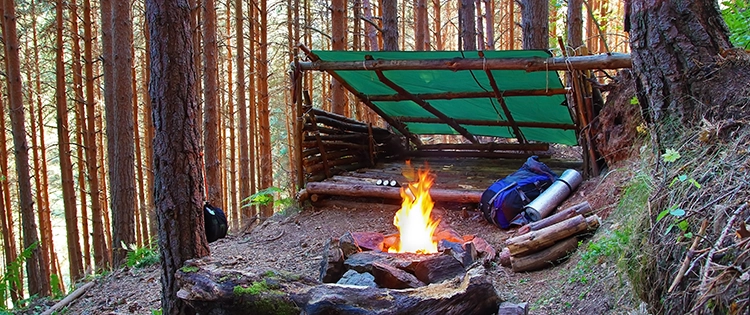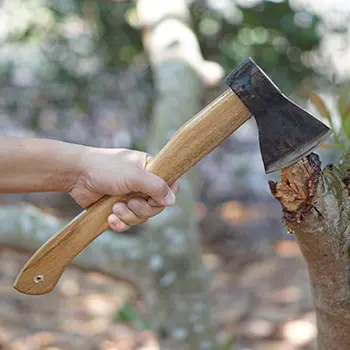There are four key aspects of survival you need to prioritize if you want to survive in the wilderness: building a fire, drinking enough clean water, finding food, and protecting yourself with shelter.
If you fail at just one of these aspects, your chances of survival are remote. Let’s focus on the last of these aspects, shelter, in greater detail.
No wilderness survival kit is complete without having items that can aid you in constructing a shelter to shield you from rain, wind, and the cold in the wilderness. Every survival kit you have (from your backpacking pack to your bug-out bag to your car survival kit) needs to have shelter-building items included in it for this reason.
There are several kinds of shelters that you can build in the wild. The items we’re going to be discussing in this article, however, are highly versatile and can be used for a wide variety of different kinds of shelters.
Here are the 11 must-have items for building a wilderness survival shelter:
Blanket
Look for blankets that are lightweight, warm, and can be folded up into a compact size for transportation. Emergency space blankets with mylar reflection will do the trick, but be wary of the kinds that are very thin and can be ripped or torn easily.
Wool blankets will also provide suitable warmth but at the expense of being heavier and taking up more space in your kit.
Duct Tape
Duct tape in general is one of the most overlooked items to include in any survival pack.
When it comes to shelter building, if your tarp or tent (which we’ll talk about in a bit) sustains any rips or tears, duct tape will be a lifesaver for patching those up.
Wilderness Long-Term Survival Guide
This guide should definitely not be missing from your backpack! Wilderness Long-Term Survival Guide is the first handbook ever that helps people NOT just to survive in the wild, BUT to LIVE there!
You can use it to make the wilderness feel like home and learn to rely on yourself in nature for a long time. This guide will help you turn the wild into a safe place you can go to in tough times.
If there’s a big crisis and you need to escape to the woods, this book will teach you how to start over from nothing, just like people did in the past when they found a spot in the middle of nowhere and began their lives again.
Fire Starting Tools and Kindling
Even though building a fire and constructing a shelter are two different aspects of survival as we talked about above, the two still go together hand-in-hand. While a shelter can provide you with protection against snow, rain, and/or wind, it’s ultimately a fire that will provide you with warmth and the ability to cook food.
Hatchet
A hatchet or a small ax will prove to be one of the most useful tools for building a shelter. You can use a hatchet to cut down small trees, hack off boughs from trees to use for the ceiling or bedding for your shelter, or chop branches from trees to use as poles.
The big advantage of a hatchet over a knife for building a shelter is that it’s more efficient for more heavy-duty work. A hatchet will always do the job faster than a knife for chopping wood, for instance.
Knife
A good knife is one of the most versatile survival tools you can keep in your kit.
When it comes to building shelter, you can use a knife to sharpen sticks to serve as stakes, cut branches from trees, cut vines to use as cordage or cut notches into poles if you need to intersect anything.
While your hatchet will be used for the more heavy-duty tasks, a knife is the better choice for more intricate or precise work. This is why both a knife and a hatchet should be included in your survival kit, instead of only one or the other.
Light Source
A flashlight or lantern is another essential item to include for building your wilderness survival shelter. Remember that you may have to set up your shelter at night or in low-light conditions.
Your job will be made immensely easier with a light source. Make sure you include at least one spare pack of batteries.
Paracord/Rope
A paracord or a rope is a must-have in any survival kit. It can be used for a multitude of survival uses, but when it comes to shelter building, rope or paracord can be used to:
- Secure your tarp or sheeting to trees
- Create a lean-to by tying the rope between two trees and then leaning poles or sticks against the rope
- Lash branches from trees together
- Create a pulley system to lift heavy objects or food up off the ground
- Securing a rainfly over your shelter
Paracord or rope will be immensely beneficial when it comes to constructing a shelter, especially if you opt not to include a tent in your kit.
Stakes
Stakes can be used to anchor your tarp or plastic sheeting to the ground.
They may not be fully necessary because you can also use rocks you find to anchor your tarp down as well and they can take up extra space and weight in your bag. It’s up to you to decide if it’s worth including them in your kit.
Tarp (or Plastic Sheeting)
A tarp is one of the most essential shelter-building tools you can have. Other than a complete tent, there are nearly no other items that can be used for flooring, a wall, or a roof all at the same time.
Furthermore, a tarp provides very good resistance against wind and rain. It’s still possible for rain to drip through a shelter that is constructed using only wooden poles and tree boughs, for instance. With a tarp that is positioned correctly, it’s virtually impossible for any rain to get through to get you wet.
As an alternative to a tarp, you can also use a plastic sheet. A tarp would be a better choice simply because of its durability and the grommets on the sides that can be used for lashing it to trees or staking it to the ground.
Take note that some people will opt to include either a tarp or a personal tent in their survival pack, while others will choose to include both. While including both would definitely add weight and bulk to your pack, you can use your tent as your primary shelter while using the tarp as a rainfly or windbreak. You’ll have to decide what you want to do here.
Tent
Some people like to take their shelter-building preparations to the next level and include a full personal tent in their survival kit. Obviously, the only kind of tent that would work in most survival kits is a lightweight tent that can be folded up to a very small size.
The benefit to including a tent in your survival kit is that it provides a very fast way of getting a shelter set up in contrast to having to assemble natural materials such as tree boughs and wooden poles to make your tent.
The downside to a tent is that even a small one will take up a lot of space and weight in your backpack or survival kit. What you can do to avoid this is learn here how to easily build a survival shelter that meets your needs.
The ability to construct a protective shelter is one of the four most critical aspects of staying alive in the wilderness.
That’s precisely why a large part of your survival pack needs to revolve around items that can be used to set up a good shelter quickly and efficiently. The items that we have discussed above will do exactly that.
This article first appeared here.
Survival Skills You Should Learn From The Amish
The Most Powerful Medicinal Plants of our Forefathers (Video)




















When I was a kid, we called that “camping.” It’s interesting that something that was once common is now referred to as “survival.”